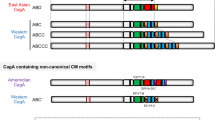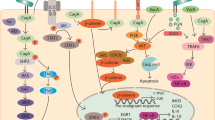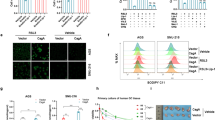Abstract
Since the discovery that Helicobacter pylori infection leads to gastric cancer, other chronic bacterial infections have been shown to cause cancer. The bacterial and host molecular mechanisms remain unclear. However, many bacteria that cause persistent infections produce toxins that specifically disrupt cellular signalling to perturb the regulation of cell growth or to induce inflammation. Other bacterial toxins directly damage DNA. Such toxins mimic carcinogens and tumour promoters and might represent a paradigm for bacterially induced carcinogenesis.
This is a preview of subscription content, access via your institution
Access options
Subscribe to this journal
Receive 12 print issues and online access
$209.00 per year
only $17.42 per issue
Buy this article
- Purchase on Springer Link
- Instant access to full article PDF
Prices may be subject to local taxes which are calculated during checkout


Similar content being viewed by others
References
Lax, A. J. & Thomas, W. How bacteria could cause cancer: one step at a time. Trends Microbiol. 10, 293–299 (2002).
Kuper, H., Adami, H. -O. & Trichopoulos, D. Infections as a major preventable cause of human cancer. J. Int. Med. 248, 171–183 (2000).
Rous, P. A sarcoma of the fowl transmissible by an agent separable from the tumour cells. J. Exp. Med. 13, 397–411 (1911).
Wazer, D. E., Liu, X.-L., Chu, Q., Gao, Q. & Band, V. Immortalization of distinct human mammary epithelial cell types by human papilloma virus 16 E6 or E7. Proc. Natl Acad. Sci. USA 92, 3687–3691 (1995).
Rosin, M. P., Saad el Din Zaki, S., Ward, A. J. & Anwar, W. A. Involvement of inflammatory reactions and elevated cell proliferation in the development of bladder cancer in schistosomiasis patients. Mutat. Res. 305, 283–292 (1994).
Uemura, N. et al. Helicobacter pylori infection and the development of gastric cancer. N. Engl. J. Med. 345, 784–789 (2001).
Siman, J. H., Forsgren, A., Berglund, G. & Floren, C. H. Association between Helicobacter pylori and gastric carcinoma in the city of Malmo, Sweden — a prospective study. Scand. J. Gastroentero. 32, 1215–1221 (1997).
Nardone, G., Rocco, A. & Malfertheiner, P. Helicobacter pylori and molecular events in precancerous gastric lesions. Aliment. Pharm. Therap. 20, 261–270 (2004).
Court, M., Robinson, P. A., Dixon, M. F. & Crabtree, J. E. Gastric Helicobacter species infection in murine and gerbil models: comparative analysis of effects of H. pylori and H. felis on gastric epithelial cell proliferation. J. Infect. Dis. 186, 1348–1352 (2002).
Naumann, M. & Crabtree, J. E. in Bacterial Protein Toxins (ed. Lax, A. J.) 169–198 (Cambridge Univ. Press, 2005).
Naito, Y. & Yoshikawa, T. Molecular and cellular mechanisms involved in Helicobacter pylori-induced inflammation and oxidative stress. Free Radic. Biol. Med. 33, 323–336 (2002).
Jüttner, S. et al. Helicobacter pylori stimulates host cyclooxygenase-2 gene transcription: critical importance of MEK/ERK-dependent activation of USF1/-2 and CREB transcription factors. Cell. Microbiol. 5, 821–834 (2003).
Kang, G. H., Lee, S., Kim, J. -S. & Jung, H. -Y. Profile of aberrant CpG island methylation along the multistep pathway of gastric carcinogenesis. Lab. Invest. 83, 635–641 (2003).
Isaacson, P. G. & Du, M. -Q. MALT lymphoma: from morphology to molecules. Nature Rev. Cancer 4, 644–653 (2004).
Caygill, C. P. J., Braddick, M., Hill, M. J., Knowles, R. L. & Sharp, J. C. M. The association between typhoid carriage, typhoid infection and subsequent cancer at a number of sites. Eur. J. Cancer Prev. 4, 187–193 (1995).
World Health Organization. Water-related diseases. Typhoid and paratyphoid eneteric diseases. <http://www.who.int/water_sanitation_health/diseases/typhoid/en> (2005).
Lecuit, M. et al. Immunoproliferative small intestinal disease associated with Campylobacter jejuni. N. Engl. J. Med. 350, 239–248 (2004).
Ferreri, A. J. M. et al. Evidence for an association between Chlamydia psittaci and ocular adnexal lymphomas. J. Natl Cancer Inst. 96, 586–594 (2004).
Brenner, A. V. et al. Previous pulmonary diseases and risk of lung cancer in Gansu Province, China. Int. J. Epidemiol. 30, 118–124 (2001).
Kreuzer, M. et al. Risk factors for lung cancer among nonsmoking women. Int. J. Cancer 100, 706–713 (2002).
Parker, A. S., Cerhan, J. R., Lynch, C. F., Leibovich, B. C. & Cantor, K. P. History of urinary tract infection and risk of renal cell carcinoma. Am. J. Epidemiol. 159, 42–48 (2004).
Luperchio, S. A. & Schauer, D. B. Molecular pathogenesis of Citrobacter rodentium and transmissible murine colonic hyperplasia. Microbes Infect. 3, 333–340 (2001).
Newman, J. V., Kosaka, T., Sheppard, B. J., Fox, J. G. & Schauer, D. B. Bacterial infection promotes colon tumorigenesis in ApcMin/+ mice. J. Infect. Dis. 184, 227–230 (2001).
Dalgleish, A. G. & O'Byrne, K. J. Chronic immune activation and inflammation in the pathogenesis of AIDS and cancer. Adv. Can. Res. 84, 231–276 (2002).
Macarthur, M., Hold, G. L. & El-Omar, E. M. Inflammation and cancer: II. role of chronic inflammation and cytokine gene polymorphisms in the pathogenesis of gastrointestinal malignancy. Am. J. Physiol. Gastrointest. Liver Physiol. 286, G515–G520 (2004).
Finch, C. E. & Crimmins, E. M. Inflammatory exposure and historical changes in human life-spans. Science 305, 1736–1739 (2004).
Cover, T. L. & Blanke, S.R. Helicobacter pylori VacA, a paradigm for toxin multifunctionality. Nature Rev. Microbiol. 3, 320–332 (2005).
Galmiche, A. et al. The N-terminal 34kDa fragment of Helicobacter pylori vacuolating cytotoxin targets mitochondria and induces cytochrome c release. EMBO J. 19, 6361–6370 (2000).
Nakayama, M. et al. Helicobacter pylori VacA activates the p38/activating transcription factor 2-mediated signal pathway in AZ-521 cells. J. Biol. Chem. 279, 7024–7028 (2004).
Censini, S. et al. cag, a pathogenicity island of Helicobacter pylori, encodes type I-specific and disease-associated virulence factors. Proc. Natl Acad. Sci. USA 93, 14648–14653 (1996).
Blaser, M. J. et al. Infection with Helicobacter pylori strains possessing cagA is associated with an increased risk of developing adenocarcinoma of the stomach. Cancer Res. 55, 2111–2115 (1995).
Selbach, M. et al. The Helicobacter pylori CagA protein induces cortactin dephosphorylation and actin rearrangement by c-Src inactivation. EMBO J. 22, 515–528 (2002).
Higashi, H. et al. SHP-2 tyrosine phosphatase as an intracellular target of Helicobacter pylori CagA protein. Science 295, 683–686 (2002).
Segal, E. D., Cha, J., Lo, J., Falkow, S. & Tompkins, L. S. Altered states: involvement of phosphorylated CagA in the induction of host cellular growth changes by Helicobacter pylori. Proc. Natl Acad. Sci. USA 96, 14559–14564 (1999).
Churin, Y. et al. Helicobacter pylori CagA protein targets the c-Met receptor and enhances the motogenic response. J. Cell Biol. 161, 249–255 (2003).
Jiang, W., Hiscox, S., Matsumoto, K. & Nakamura, T. Hepatocyte growth factor/scatter factor, its molecular, cellular and clinical implication in cancer. Crit. Rev. Oncol. Hemat. 29, 209–248 (1999).
Higashi, H. et al. Biological activity of the Helicobacter pylori virulence factor CagA is determined by variation in the tyrosine phosphorylation sites. Proc. Natl Acad. Sci. USA 99, 14428–14433 (2002).
Li, S. D. et al. Multiple genes in the left half of the cag pathogenicity island of Helicobacter pylori are required for tyrosine kinase-dependent transcription of interleukin-8 in gastric epithelial cells. Infect. Immun. 67, 3893–3899 (1999).
Viala, J. et al. Nod1 responds to peptidoglycan delivered by the Helicobacter pylori cag pathogenicity island. Nature Immunol. 5, 1166–1174 (2004).
Mundy, R. et al. Identification of a novel Citrobacter rodentium type III secreted protein, EspI, and roles of this and other secreted proteins in infection. Infect. Immun. 72, 2288–2302 (2004).
Lax, A. J. et al. The Pasteurella multocida toxin interacts with signalling pathways to perturb cell growth and differentiation. Int. J. Med. Microbiol. 293, 505–512 (2004).
Dyer, N. W., Haynes, J. S., Ackermann, M. R. & Rimler, R. B. Morphological effects of Pasteurella multocida type-D dermonecrotoxin on rat osteosarcoma cells in a nude mouse model. J. Comp. Pathol. 119, 149–158 (1998).
Pullinger, G. D., Bevir, T. & Lax, A. J. The Pasteurella multocida toxin is encoded within a lysogenic bacteriophage. Mol. Microbiol. 51, 255–269 (2004).
Landraud, L. et al. E. coli CNF1 toxin: a two-in-one system for host-cell invasion. Int. J. Med. Microbiol. 293, 513–518 (2004).
Thomas, W. et al. Cytotoxic necrotizing factor from Escherichia coli induces RhoA-dependent expression of the cyclooxygenase-2 gene. Infect. Immun. 69, 6839–6845 (2001).
Korinek, V. et al. Constitutive transcriptional activation by a β-catenin–Tcf complex in APC−/− colon carcinoma. Science 275, 1784–1787 (1997).
Wu, S., Morin, P. J., Maouyo, D. & Sears, C. L. Bacteroides fragilis enterotoxin induces c-myc expression and cellular proliferation. Gastroenterol. 124, 392–400 (2003).
Frisan, T., Cortes-Bratti, X. & Thelestam, M. Cytolethal distending toxins and activation of DNA damage-dependent checkpoint responses. Int. J. Med. Microbiol. 291, 495–499 (2002).
McSweeney, L. A. & Dreyfus, L. A. Nuclear localization of the Escherichia coli cytolethal distending toxin CdtB subunit. Cell. Microbiol. 6, 447–458 (2004).
Hassane, D. C., Lee, R. B. & Pickett, C. L. Campylobacter jejuni cytolethal distending toxin promotes DNA repair responses in normal human cells. Infect. Immun. 71, 541–545 (2003).
Haghjoo, E. & Galán, J. E. Salmonella typhi encodes a functional cytolethal distending toxin that is delivered into host cells by a bacterial-internalization pathway. Proc. Natl Acad. Sci. USA 101, 4614–4619 (2004).
Marchès, O. et al. Enteropathogenic and enterohaemorrhagic Escherichia coli deliver a novel effector called Cif, which blocks cell cycle G2/M transition. Mol. Microbiol. 50, 1553–1567 (2003).
Janka, A. et al. Cytolethal distending toxin gene cluster in enterohemorrhagic Escherichia coli O157:H− and O157:H7: characterization and evolutionary considerations. Infect. Immun. 71, 3634–3638 (2003).
Rippere-Lampe, K. E. et al. Cytotoxic necrotizing factor type 1-positive Escherichia coli causes increased inflammation and tissue damage to the prostate in a rat prostatitis model. Infect. Immun. 69, 6515–6519 (2001).
Justice, S. S. et al. Differentiation and developmental pathways of uropathogenic Escherichia coli in urinary tract pathogenesis. Proc. Natl Acad. Sci. USA 101, 1333–1338 (2004).
Mulvey, M. A., Schilling, J. D. & Hultgren, S. J. Establishment of a persistent Escherichia coli reservoir during the acute phase of a bladder infection. Infect. Immun. 69, 4572–4579 (2001).
Acknowledgements
I am grateful to A. Grigoriadis, K. Homer, A. Hosie, R. Palmer, R. Reljic, L. Samson, B. Thomas and W. Wade for helpful comments on the manuscript.
Author information
Authors and Affiliations
Ethics declarations
Competing interests
The author declares no competing financial interests.
Related links
Related links
DATABASES
Entrez
FURTHER INFORMATION
Rights and permissions
About this article
Cite this article
Lax, A. Bacterial toxins and cancer — a case to answer?. Nat Rev Microbiol 3, 343–349 (2005). https://doi.org/10.1038/nrmicro1130
Issue Date:
DOI: https://doi.org/10.1038/nrmicro1130
This article is cited by
-
Streptococcal bacterial components in cancer therapy
Cancer Gene Therapy (2022)
-
Anticancer activity of Helicobacter pylori ribosomal protein (HPRP) with iRGD in treatment of colon cancer
Journal of Cancer Research and Clinical Oncology (2021)
-
The role of bacteria in cancer therapy – enemies in the past, but allies at present
Infectious Agents and Cancer (2018)
-
Mucosal microbiota of intestinal polyps reveals putative biomarkers of colorectal cancer
Scientific Reports (2018)
-
Enterobacter Strains Might Promote Colon Cancer
Current Microbiology (2015)



